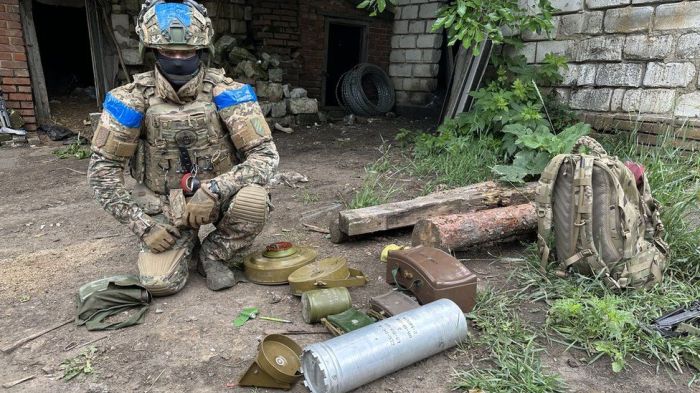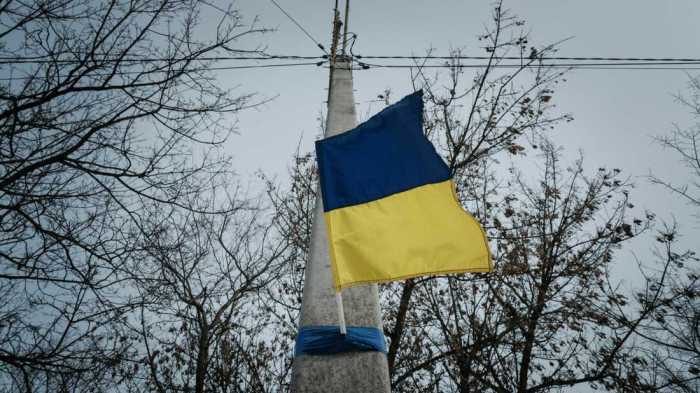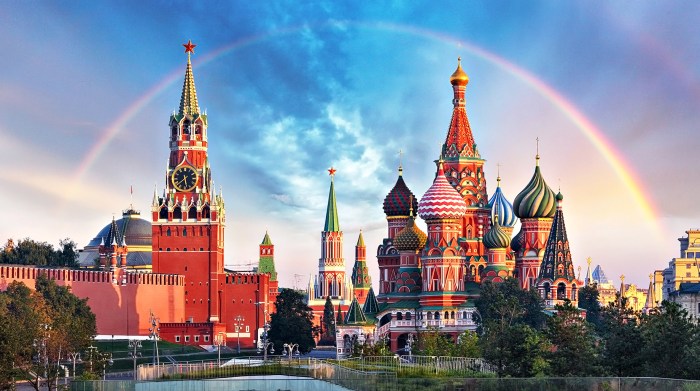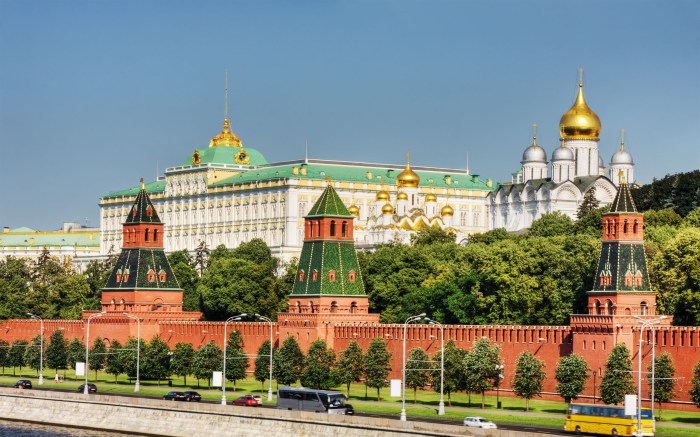
Ukraine says it hit russias bridge crimea with underwater explosives – Ukraine says it hit Russia’s bridge in Crimea with underwater explosives, a dramatic escalation in the conflict. The Crimean Bridge, a vital link for Russia, is a key strategic asset. Ukraine claims the attack was carried out using underwater explosives, targeting the bridge’s infrastructure. This action has significant implications for both the immediate logistical challenges for Russia and the potential for further escalation in the conflict.
The bridge, connecting Russia to Crimea, plays a crucial role in military and economic supply lines. Its destruction will likely disrupt Russian transport and logistics, potentially impacting their ability to reinforce troops and supply their forces. The economic repercussions of this attack could be considerable, impacting Russia’s ability to sustain the war effort. This incident follows a pattern of attacks on critical infrastructure in the region and could significantly alter the trajectory of the conflict.
Background of the Incident
The Kerch Strait Bridge, connecting Russia’s mainland to Crimea, has become a focal point in the ongoing conflict. Its strategic importance for Russia extends beyond simple transportation; it’s a vital artery for military supplies and reinforcement of the Crimean peninsula. The bridge’s destruction would be a significant blow to Russian logistical capabilities and symbolic of the ongoing conflict.The bridge’s construction, completed in 2018, followed Russia’s annexation of Crimea in 2014.
This annexation was met with international condemnation and continues to be a point of contention. The bridge’s existence is intrinsically linked to Russia’s claim of control over Crimea.
Ukraine’s Stated Justifications
Ukraine has claimed responsibility for the attack on the Crimean Bridge, citing it as a legitimate act of self-defense. Their justification revolves around the bridge’s use in facilitating the Russian invasion and subsequent war effort. Ukraine has consistently asserted that the bridge serves as a crucial supply line for Russian military operations.
Strategic Importance of the Crimean Bridge to Russia
The Crimean Bridge is a critical link for Russia. It allows for the transport of military equipment, personnel, and supplies to Crimea, a strategically important territory for Russia. Disruption of this supply route would severely impact Russian military operations in the region.
Method of Attack: Underwater Explosives
Ukraine has claimed to use underwater explosives in the attack on the Crimean Bridge. This method is designed to inflict significant damage to the bridge’s infrastructure, particularly its supporting structures and the bridge deck. Such an attack would disrupt the flow of vehicles and supplies across the bridge. Previous attacks on bridges using similar tactics have resulted in significant damage and disruption.
Previous Attacks on the Bridge or Similar Infrastructure
While this attack is significant, it’s not the first time infrastructure critical to Russia’s war effort has been targeted. There have been several incidents of attacks on bridges, and other supply lines, throughout the conflict. These actions highlight the ongoing struggle and the importance of securing critical infrastructure in times of war. The targeting of such vital infrastructure demonstrates a clear shift in the war’s dynamics.
Impact and Aftermath: Ukraine Says It Hit Russias Bridge Crimea With Underwater Explosives
The Ukrainian strike on the Crimean Bridge, utilizing underwater explosives, sent shockwaves through the Russian logistical network and ignited a firestorm of international responses. This act of defiance has the potential to significantly alter the trajectory of the conflict, forcing a reassessment of both military strategies and economic stability. The immediate consequences are manifold, impacting everything from transport and logistics to potential escalation and global reactions.
Immediate Effects on Russian Transport and Logistics
The Crimean Bridge serves as a crucial artery for transporting goods and personnel between Russia and the Crimean Peninsula. Its damage has immediately disrupted the flow of supplies and troops, impacting military movements and the overall war effort. This disruption likely extends to civilian transport, impacting travel and the movement of essential goods. The repair process, which will undoubtedly be costly and time-consuming, will further exacerbate the logistical challenges faced by Russia.
Estimates of repair time vary significantly, but any delay could have profound impacts on the overall Russian war effort.
Potential Economic Repercussions
The damage to the Crimean Bridge will inevitably lead to significant economic losses for Russia. The disruption of trade, both military and civilian, will have ripple effects across various sectors of the Russian economy. This disruption could lead to price increases for goods and services, particularly those reliant on the bridge’s transport routes. The cost of repairs, likely in the billions of dollars, will further strain the Russian economy, diverting resources from other critical areas.
This incident could potentially affect investor confidence in the Russian market. A similar situation occurred during the 2022 invasion of Ukraine, where the destruction of Ukrainian infrastructure significantly hampered the Russian war machine and also the Ukrainian economy.
Possible Escalation of the Conflict
The attack on the Crimean Bridge is a significant escalation of the conflict, with potential implications for the broader geopolitical landscape. Russia’s response to the attack could range from further military actions to heightened rhetoric. The possibility of retaliatory strikes against Ukrainian infrastructure or other targets cannot be ruled out. This could significantly escalate the conflict, potentially leading to a wider war.
This incident echoes similar escalatory events throughout history, where actions by one party are met with retaliatory measures, often with unforeseen consequences.
International Reaction to the Attack
The international community has largely condemned the attack on the Crimean Bridge. Many countries have voiced their support for Ukraine, emphasizing the need for accountability and condemning Russia’s actions. Western countries have announced further sanctions against Russia, aiming to restrict its ability to finance and sustain its military operations. The international response, while condemning Russia’s actions, has varied in terms of the level of direct involvement, reflecting the complexities of the situation.
Ukraine’s claim of hitting Russia’s Crimean Bridge with underwater explosives is certainly a significant development. It’s fascinating to consider the tactics involved, but it also reminds me of the incredible stories of resilience and determination, like those featured in the Carter’s documentary about Nick Aaron Angel, a true story of overcoming adversity the carters documentary nick aaron angel true story.
Ultimately, the ingenuity employed in such situations often reflects the desperation and resolve of those involved in the conflict in Ukraine.
Timeline of Events Following the Attack
- Initial Reports: Reports of an explosion on the Crimean Bridge emerge. Initial reports often differ in accuracy, as the conflict evolves.
- Confirmation of Damage: Images and videos confirm significant damage to the bridge. Initial assessment often highlights the extent of damage, but the full picture takes time to unfold.
- International Condemnation: Various international bodies and countries condemn the attack. The severity of condemnation varies depending on the relationship with Russia and Ukraine.
- Russian Response: Russia claims responsibility for the incident and issues various statements. These responses are often met with scrutiny from the international community.
- Ongoing Investigation: Investigations into the incident begin. The investigation may take weeks or months to produce conclusive findings, depending on the circumstances.
Military Analysis
The recent attack on the Crimean Bridge using underwater explosives presents a fascinating case study in asymmetric warfare. While the immediate impact is evident, the long-term implications for military strategy and infrastructure vulnerability are significant. This analysis delves into the effectiveness of such tactics, the potential risks and rewards for Ukraine, and the likely countermeasures from Russia.The use of underwater explosives to target critical infrastructure like bridges is not entirely novel.
Historical precedents demonstrate the potential for this type of attack to inflict significant damage. However, the specific challenges and complexities inherent in targeting a bridge, particularly one with strategic importance, necessitate a detailed examination.
Ukraine’s claim of hitting Russia’s Crimean Bridge with underwater explosives is a significant development, raising questions about escalating tactics in the conflict. While this news dominates headlines, it’s important to remember the ongoing struggles for peace in the Middle East, particularly the Kurdish quest for a more stable and peaceful future in the region. This complex situation, as highlighted in this piece on kurdish middle east peace , demonstrates the interconnectedness of global conflicts and the need for diplomatic solutions beyond the current battlefield realities.
The Ukrainian offensive continues to reshape the geopolitical landscape, demanding careful consideration of all sides and potential consequences.
Effectiveness of Underwater Explosives
Underwater explosives, due to their ability to generate powerful shockwaves, can effectively target structural foundations. The damage inflicted on the bridge supports is the primary concern, as damage to these foundations can lead to the collapse of the entire structure. However, the effectiveness of such attacks is highly contingent on the specific location of the detonation, the type of explosive used, and the design of the target structure.
Potential Risks and Rewards for Ukraine
Employing this type of attack presents a calculated risk for Ukraine. The potential reward is significant disruption to Russian logistics and morale. However, the risk of retaliation is substantial, potentially escalating the conflict and drawing international condemnation. The strategic gains must be weighed against the potential consequences.
Potential Damage to Bridge Structural Integrity
The successful detonation of underwater explosives can lead to severe damage to the bridge’s structural integrity. Damage to supporting piers and foundations, if significant, can compromise the entire bridge’s load-bearing capacity. The extent of the damage will depend on the quantity and type of explosives used, the depth of the detonation, and the specific construction of the bridge supports.
Possible Countermeasures Russia Might Take, Ukraine says it hit russias bridge crimea with underwater explosives
Russia is likely to respond to the attack with heightened security measures, increased surveillance, and potentially improved infrastructure protection. These measures could include deploying more security personnel, reinforcing the bridge’s foundations, and implementing advanced detection systems. The choice of countermeasures will depend on the assessment of the damage and the perceived threat level.
Possible Targets and Their Vulnerability
| Target | Vulnerability | Potential Damage | Countermeasures |
|---|---|---|---|
| Bridge Support | High | Severe Damage, potentially complete collapse of the support section. | Reinforcement of the supports with stronger materials, or the addition of additional support structures. |
| Traffic Flow | Moderate | Disruption of traffic, temporary closure of the bridge. | Increased security patrols, alternative transportation routes, and temporary traffic control measures. |
| Navigation Channel | Low | Minor disruption to shipping traffic. | Enhanced surveillance and patrols to monitor for further attacks. |
International Relations
The attack on the Crimean Bridge, attributed to Ukraine, has sent ripples through international relations, highlighting the complex web of geopolitical tensions and the potential for escalation. This act of strategic sabotage raises questions about the future of the conflict and the role of international actors in de-escalation efforts. The incident necessitates a careful examination of its potential impact on global security and the dynamics of the conflict.
Ukraine’s claim of hitting Russia’s Crimean Bridge with underwater explosives is certainly intriguing. It’s reminiscent of some of the intense, almost ballet-like, action sequences you see in movies like the John Wick Ballerina ending. This particular ending really highlights the kind of calculated precision needed for such an operation. Still, the real-world implications of these underwater attacks on critical infrastructure remain to be seen.
Potential Implications for International Relations
The attack on the Crimean Bridge, a vital transportation link, carries significant implications for international relations. The incident could potentially exacerbate existing tensions between Russia and Ukraine’s allies, particularly Western nations. This could lead to a further hardening of positions and a reduction in avenues for diplomatic engagement. The international community is faced with a challenging task in navigating these fraught waters.
Comparison to Other Acts of Sabotage
This attack on the Crimean Bridge can be compared to other acts of sabotage in conflict zones, including the destruction of infrastructure and strategic targets. The precedent set by these actions is a critical factor in understanding the evolving nature of warfare. While the specific context of each incident varies, a recurring theme is the use of non-conventional tactics to disrupt supply lines and undermine the enemy’s logistical capabilities.
This pattern highlights the changing nature of conflict and the potential for further escalation.
Statements from World Leaders
Statements from world leaders regarding the attack have been varied and often reflect the complexities of the geopolitical situation. Some leaders have expressed condemnation of the act, while others have refrained from taking a definitive stance, perhaps to avoid further alienating one side or the other. This reflects the delicate balance of power and the need for diplomatic nuance in international relations.
Role of International Organizations
International organizations, such as the United Nations, have a crucial role to play in mediating conflicts and promoting peaceful resolutions. However, their effectiveness is often hampered by the differing interests and perspectives of member states. In this case, the role of international organizations is likely to be crucial in fostering dialogue and de-escalating the situation.
Differing Opinions on the Incident
| Country | Stance | Reasoning |
|---|---|---|
| Russia | Strongly condemns the attack | Views the attack as an act of terrorism and a violation of its sovereignty. Accuses Ukraine of orchestrating the attack. |
| Ukraine | Claims responsibility | Argues the attack was a legitimate act of self-defense to counter Russia’s aggression and damage to critical infrastructure. |
| United States | Condemns the attack | Expresses concern over the incident’s potential implications for regional stability. However, avoids explicitly blaming any one side. |
| European Union | Calls for de-escalation | Emphasizes the importance of diplomacy and avoiding further escalation of the conflict. |
Public Perception

The attack on the Crimean Bridge has ignited a firestorm of public opinion, with starkly contrasting narratives emerging in Ukraine and Russia. Public perception is heavily influenced by the prevailing information landscape, often shaped by government-controlled media and social media campaigns. This analysis delves into the divergent perspectives and the role of propaganda in shaping public opinion.The attack on the Crimean Bridge has amplified existing tensions and anxieties.
In Ukraine, the event is viewed as a justified act of retaliation against Russian aggression. Conversely, in Russia, the attack is framed as a malicious act by Ukraine, further fueling nationalistic fervor and resentment. This polarized response demonstrates the profound impact of differing narratives and the difficulty of achieving a neutral understanding.
Ukrainian Public Perception
The Ukrainian public overwhelmingly views the attack as a strategic blow against Russia’s military capabilities and a symbolic rejection of its occupation of Crimea. The attack is framed as a necessary action to counter Russian aggression and to protect Ukrainian sovereignty. Governmental pronouncements and media portrayals emphasize the attack’s effectiveness and strategic significance.
Russian Public Perception
The Russian public, largely exposed to state-controlled media, perceives the attack as an act of terrorism perpetrated by Ukraine. This narrative emphasizes the alleged violation of Russian sovereignty and the need for a strong response to defend Russian interests. Pro-war rhetoric and narratives of external threats are prevalent, further consolidating public support for the ongoing conflict.
Role of Propaganda
Propaganda plays a significant role in shaping public opinion in both countries. In Ukraine, the narrative emphasizes the fight for national liberation and the need for international support. In Russia, the narrative focuses on national unity and the necessity of defending the country from external threats. These narratives, often fueled by misinformation and biased reporting, contribute to a deeply polarized public discourse.
Social Media’s Role
Social media platforms have become crucial arenas for disseminating information and shaping public opinion surrounding the incident. The rapid spread of information, both verified and false, often takes place before official sources can provide context. This creates an environment where misinformation and propaganda can easily take hold and influence public sentiment.
“This is a clear act of aggression. We will not stand for this.”
This quote exemplifies a typical social media post reflecting the prevailing sentiment in Ukraine, highlighting the aggressive stance and condemnation of the attack. Similar posts expressing outrage and support for Ukraine are prevalent on social media platforms. Conversely, Russian social media posts frequently condemn the attack and depict it as an act of terrorism. These differing narratives reflect the powerful influence of social media in amplifying and spreading pre-existing opinions.
Potential Future Developments

The attack on the Crimean Bridge marks a significant escalation in the conflict, raising concerns about potential future actions and responses. Understanding the potential ramifications is crucial for assessing the evolving geopolitical landscape. Predicting the precise course of events is inherently challenging, but examining potential targets, Russian reactions, and escalation/de-escalation scenarios can offer valuable insights.
Potential Future Targets
The Crimean Bridge attack demonstrated a new tactic in hybrid warfare, utilizing underwater explosives to disrupt critical infrastructure. This suggests potential future targets that are vulnerable to similar attacks. Bridges, pipelines, and other strategically important infrastructure within occupied territories, or those crucial to Russia’s supply lines, are likely candidates. This includes infrastructure vital to Russian military operations, such as bridges connecting occupied territories to the mainland or logistical supply lines for troops and equipment.
Further, vulnerable ports or rail junctions could be potential targets for disruption.
Potential Responses from Russia
Russia’s response to the attack will likely be multifaceted. Retaliatory actions, both military and economic, are plausible. Targeted strikes against Ukrainian infrastructure, potentially expanding the conflict’s scope, could be a possibility. There’s also a chance of stepped-up cyberattacks aimed at disrupting Ukrainian communications or critical infrastructure. Moreover, Russia might attempt to increase its military presence in occupied areas as a show of force.
A campaign of disinformation and propaganda to influence public opinion both domestically and internationally is also a possibility.
Possible Scenarios for Escalation or De-escalation
The likelihood of escalation or de-escalation depends on a complex interplay of factors, including international reactions, the Ukrainian response, and the actions of both sides. Escalation could involve intensified military actions by Russia, leading to a wider conflict or a direct confrontation with NATO forces. De-escalation, on the other hand, is dependent on both sides seeking diplomatic solutions.
This may involve a ceasefire or the negotiation of a new set of terms in the conflict.
Potential Outcomes from the Attack
The attack on the Crimean Bridge has profound implications for the future of the conflict. It could lead to a more protracted war, as Russia seeks to retaliate or reassert control. It could also accelerate the pace of the conflict, leading to further escalation. Increased international sanctions and isolation of Russia are potential outcomes, as well as a possible shift in the global balance of power.
Additionally, the attack could significantly damage Russia’s reputation and international standing.
Potential Future Scenarios
| Scenario | Likelihood | Impact |
|---|---|---|
| Escalation | Moderate | Increased violence, potential for wider conflict, heightened international tensions. |
| De-escalation | Low | Reduced violence, potential for diplomatic solutions, but likely temporary and dependent on external pressures. |
| Stalemate | High | Continued conflict with limited gains on either side, possibly leading to a prolonged period of instability. |
Final Thoughts
The attack on the Crimean Bridge marks a significant escalation in the conflict, raising questions about the future trajectory of the war. The international reaction will be crucial in determining how the situation evolves. Ukraine’s actions raise questions about the effectiveness of underwater explosives against critical infrastructure and the potential risks and rewards for them. Further analysis will reveal the long-term impacts on both sides, but the immediate effect on Russia’s supply lines is undeniable.
This incident underscores the complex interplay of military strategy, international relations, and public perception in a global conflict.







